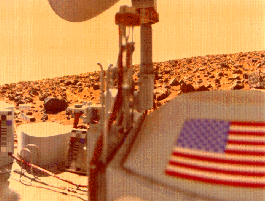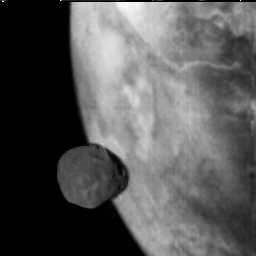While Mars may have started out with characteristics similar to Earth, because of it's small size it's interior has sinced cooled and it was unable to retain a substantial atmosphere.
 Interior of Mars
Interior of Mars
The interior of Mars is known only by inference from
surface data and the bulk statistics of the planet. The dense
core is about 1700 km in radius. Mars has a molten rocky mantle somewhat
denser than the Earth's and a thin crust. Mars' low density
indicates its core contains a large fraction of sulfur in addition
to iron and iron sulfide. Mars lacks active plate tectonics at
present; there is no evidence of recent horizontal motion of the surface such
as the folded mountains so common on Earth. Moreover, the Martian crust is
quite thick, now.
Magnetic Field?
Large, but not global, weak magnetic fields exist in various regions of
Mars. This unexpected finding was made by Mars Global Surveyor just days
after it entered Mars orbit. They are remnants of an earlier global
field that has since disappeared, now that the core has cooled.
 The Early Atmosphere
The Early Atmosphere
All evidence points towards a more dense atmosphere in the past.
However, lacking the Earth's plate tectonics, Mars was unable to recycle
any of this carbon dioxide back into its atmosphere. Still more was
lost to space from the Solar Wind. As the pressure dropped with the
thinning atmosphere, liquid water could no longer exist on its
surface, and Mars has become the dry, desolate, cold world it is today.
 The Mars Satellites: Phobos and Deimos
The Mars Satellites: Phobos and Deimos
Phobos ("FOH bus") is the innermost, larger of Mars' two moons. Phobos
is closer to its primary than any other moon in the solar system, just
6000 km above Mars surface. Deimos ("DEE mos") is the smallest
known moon in the solar system.
Just like our Moon, Deimos and Phobos are tidally locked to their host planet, keeping the same face to Mars as they follow their orbits. They are composed of carbon-rich rock like the asteroids. Both are heavily cratered and irregularly shaped. Phobos shows deep fractures from major impacts. They are thought to be asteroids perturbed by Jupiter into orbits that allowed them to be captured by Mars.
 Because it is so close to Mars, loose material on Phobos will be
tidally pulled off and fall onto Mars. Moreover, Phobos is doomed:
because its orbit is so low, tidal forces are pulling the moon in!
(current rate: about 1.8 meters per century). In about 50 million
years it will either crash onto the surface of Mars or (more likely)
break up into a ring.
Because it is so close to Mars, loose material on Phobos will be
tidally pulled off and fall onto Mars. Moreover, Phobos is doomed:
because its orbit is so low, tidal forces are pulling the moon in!
(current rate: about 1.8 meters per century). In about 50 million
years it will either crash onto the surface of Mars or (more likely)
break up into a ring.